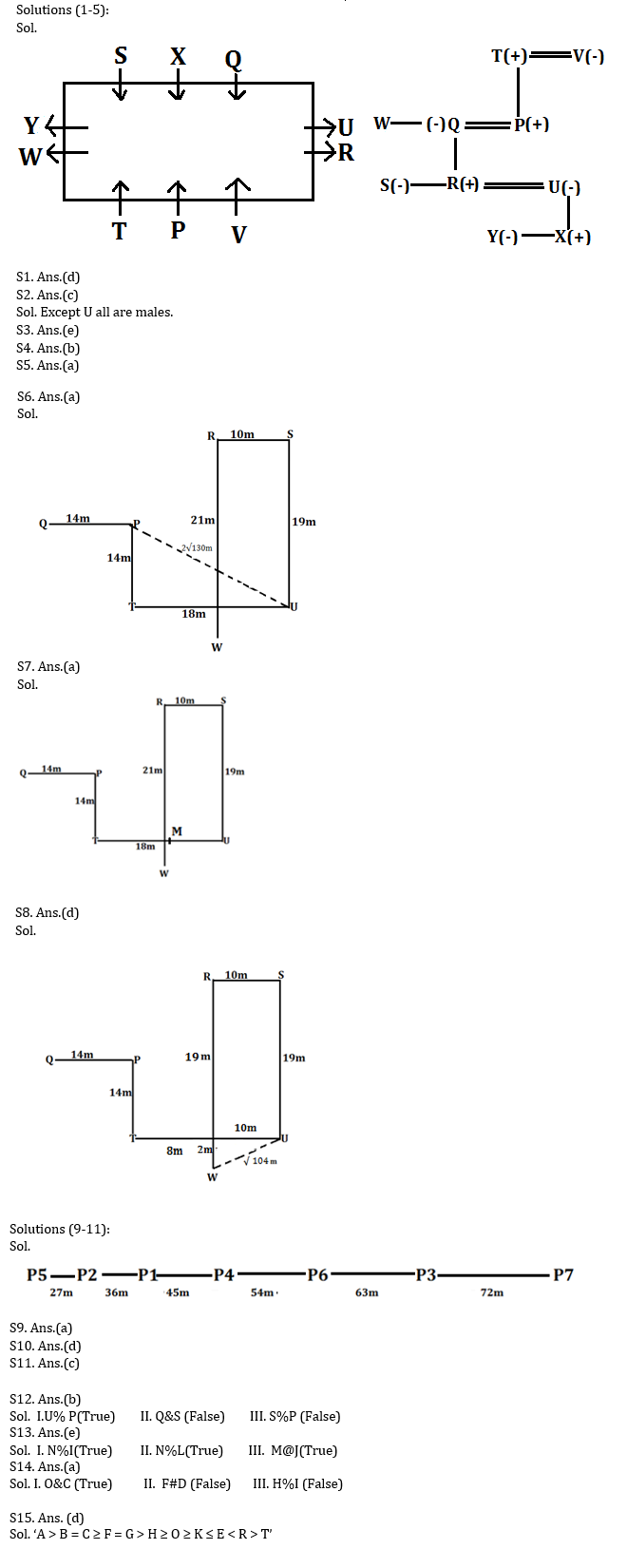Directions (1-5): Study the following information carefully to answer the given questions.
Ten persons of a same family i.e. P, Q, R, S, T, U, V, W, X and Y are sitting around a rectangular table in such a way that three of them are sitting at each of the longer side of the table and faces towards the centre and two of them are sitting on each of the shorter side of the table and faces away from the centre. All the information is not necessarily in the same order.
P who is father of R sits third to the right of Q’s daughter-in-law. W sits at the immediate left of Q’s father in law who is married with V. P is the only child of V who sits opposite to the one who sits at the immediate left of R’s wife. X is son of U who is a female member. S is paternal aunt of X and sits second to the right of Q’s only sibling. W sits only with Y who is child of U. Y is not nephew of S. R has more than one child. W is not married and sits opposite to R. R’s spouse sits on the same side with R. P’s wife sits at the immediate left of Y sibling.
Q1. How T is related to the one who is sitting second to the left of Q?
(a) Sister
(b) Brother
(c) Father
(d) Grand father
(e) Grand mother
Q2. Four of the following are alike in a certain way so form a group, which of the following does not belong to that group?
(a)R
(b)X
(c)U
(d)P
(e)T
Q3. How many persons are sitting between S and V when counted from the right of V?
(a)One
(b)Two
(c)Five
(d)Three
(e)Four
Q4.Which of the following statement is not true?
(a)S, X and Q sits together on the same side of the table
(b) Q sits opposite to P
(c) Q sits at the immediate left of X.
(d) T is father in law of Q
(e) S sits opposite to T
Q5. How many female members are there in the family?
(a)Can’t be determined
(b) Six
(c) Seven
(d) Five
(e) Four
Directions (6-8): Study the following information carefully and answer the questions given below.
A@B (6)- A is 10m in north of B
A$B (10)- A is 14m in south of B
A%B (12)- A is 10m in east of B
A&B (15)- A is 13m in west of B
P%Q(16), R&S(12), T&U(20), U$S(15), P@T(10), W$R(17)
Q6. What is the shortest distance between point P and point U?
(a)2√130m
(b) 520m
(c) 130m
(d) 260m
(e) None of these
Q7. If M is the mid point of the line segment TU, then determine the distance between the point T and point M?
(a) 9m
(b)10m
(c) 8m
(d) None of these
(e) 7m
Q8. What is the shortest distance between the point U and point W?
(a)85m
(b)120m
(c)None of these
(d)√104m
(e) √130m
Directions (9-11): Study the following information carefully to answer the given questions.
Seven plants are planted across the road at a particular distance in a row such that the distance between each of the two plants is a multiple of nine (successive multiple is taken). All the information is not necessarily in the same order.
The distance between the P2 and P6 is 135m. Not more than two plants are planted to the right of P6. P6 is planted to the right of P4. The distance between P1 and P4 is 45m. Only two plants are planted between P5 and P4. P4 is planted to the right of P2. The distance between the P6 and P7 is same as that of P2 and P6. P7 is planted just next to the P3.
Q9. How many plants are planted between P7 and P2?
(a) Four
(b) Two
(c) Three
(d) Five
(e) None of these
Q10. What is the total distance between the plants P1 and P5?
(a) 62m
(b) 65m
(c) 64m
(d) 63m
(e) None of these
Q11. What is the distance between the plants P5 and P2?
(a) 18m
(b) 36m
(c) 27m
(d) 72m
(e) None of these
Directions (12-14): In the following questions, the symbols @ , # ,$ , % and & are used with the following meaning as illustrated below-
‘A@B’ means ‘B is smaller than or equal to A’
‘A#B’ means ‘B is greater than or equal to A’
‘A$B’ means ‘B is equal to A ’
‘A%B’ means ‘B is greater than A’
‘A&B’ means ‘B is smaller than A ’
Now in each of the following questions assuming the given statements to be true, find which of the three conclusions I, II and III given below them is/are definitely true and give your answer accordingly.
Q12.Statements:
P& Q$ R@ U ; S @R @T @U ; V% W& U# Q
Conclusions:
I. U% P
II. Q&S
III. S%P
(a) Only II is true
(b) Only I is true
(c) Both I and II are true
(d) Both I and III are true
(e) All are true
Q13. Statements:
I&J#K%L ; M$K@O ; N$J$P%L
Conclusions:
I. N%I
II. N%L
III. M@J
(a) Only II is true
(b) Only I is true
(c) Both I and II are true
(d) Both I and III are true
(e) All are true
Q14. Statements:
G&D$H#O; C%D#E@I ; K&F#I
Conclusions:
I.O&C
II.F#D
III.H%I
(a) Only I is true
(b) Only III is true
(c) Both II and III are true
(d) Both I and III are true
(e) All are true
Q15. Which of the following symbols should replace the sign ($) and (#) in the given expression in order to make the expressions B ≥ G and F > K definitely true?
‘A > B $ C ≥ F = G > H # O ≥ K ≤ E < R > T’
(a) ≥, <
(b) ≥, ≤
(c) >, =
(d) =, ≥
(e) <, ≤
Solutions

Click Here to Register for Bank Exams 2021 Preparation Material





 GA Capsule for SBI Clerk Mains 2025, Dow...
GA Capsule for SBI Clerk Mains 2025, Dow...
 The Hindu Review October 2022: Download ...
The Hindu Review October 2022: Download ...
 SBI Clerk Prelims Result 2025 Out, Direc...
SBI Clerk Prelims Result 2025 Out, Direc...







